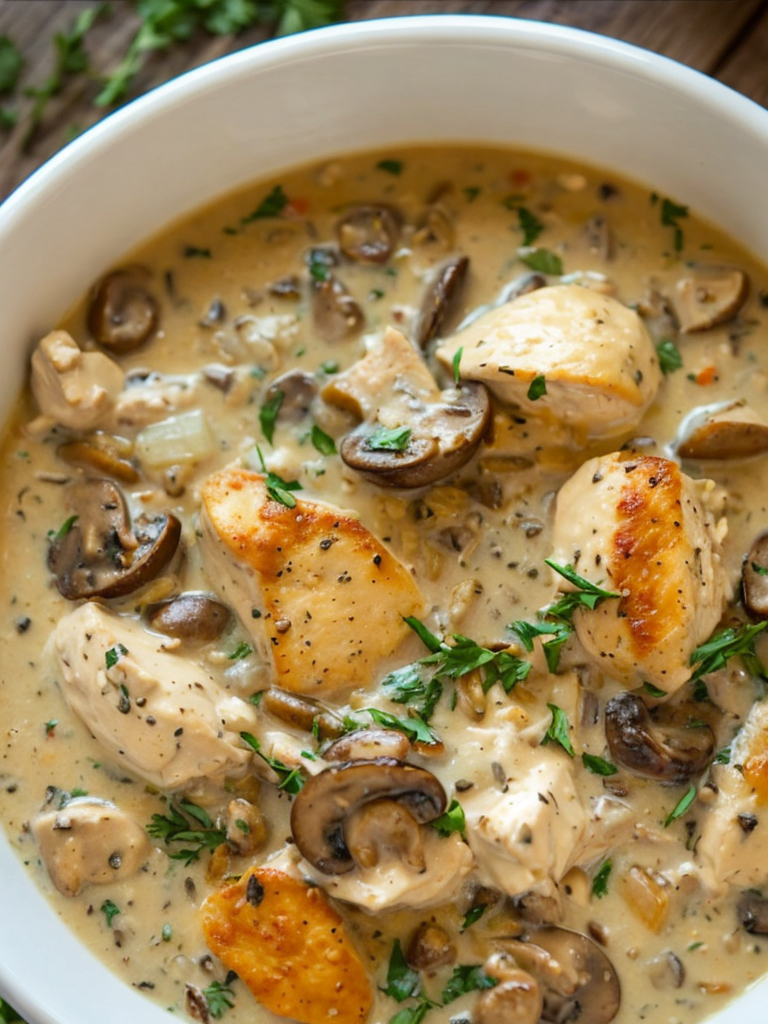Ultimate Flu Fighter Chicken Noodle Soup – Ready in 30 Min
Ultimate Flu Fighter Chicken Noodle Soup – The Health Boost You Need
Dive into a bowl of comfort with our Ultimate Flu Fighter Chicken Noodle Soup, perfect for boosting your immune system when the cold breeze starts to bite. Packed with tender chicken, wholesome vegetables, and aromatic herbs, this soothing concoction envelops you in warmth and well-being. The simplicity and quick cooking time make it a favorite go-to meal during the chilly season.
This chicken noodle soup is more than just a meal; it’s an embrace in a bowl, engineered to fight off flu symptoms with its wholesome nutrients. Rich and savory in flavor, each spoonful serves as a strengthening tonic for the body and soul. Picture yourself savoring a hot, steamy bowl filled with golden, aromatic broth, providing relief during the winter season or any time you’re feeling under the weather.
Quick Recipe Highlights
- Flavor Profile: Delightfully savory with a balance of aromatic herbs, earthy roots, and a hint of sweetness from fresh vegetables.
- Texture: Tender chunks of chicken paired with silky noodles, all bathed in a robust, hearty broth.
- Aroma: Inviting scents of thyme and bay leaves mixed with the comforting smell of slow-cooked chicken.
- Visual Appeal: A vibrant medley of carrots, celery, and chicken in a golden broth, accented by fresh herbs.
- Skill Level Needed: Designed for cooks of all levels, this soup requires basic chopping and simple simmering.
- Special Equipment: A large pot for the stew and a sharp knife for prep work are all you need.
Recipe Overview
- Difficulty Level: Simple instructions make it easy even for beginner cooks; just prepare ingredients and combine them in steps.
- Category: Soups & Stews, an ideal choice for lunch, dinner, or a comforting snack.
- Cuisine: Rooted in a rich culinary tradition, this classic American dish takes inspiration from diverse chicken soup recipes worldwide.
- Cost: Budget-friendly with affordable ingredients like chicken, noodles, and everyday vegetables.
- Season: Best enjoyed during fall and winter when the need for warmth and nutrition peaks.
- Occasion: Perfect for family gatherings, a soothing solo meal, or when recovering from illness.
Why You’ll Love This Recipe
This recipe’s rich, savory taste combined with the tender consistency of perfectly cooked noodles makes it an all-time comfort favorite. Easy to prepare with ingredients found around most kitchens, it suits even the busiest of schedules. Nutritionally, it offers a robust blend of proteins, carbohydrates, and healing herbs known to alleviate cold symptoms.
Socially, sharing a pot of this soup can bring family and friends together, creating an aura of love and care around the table. It’s cost-effective, leveraging staple items without sacrificing flavor or satisfaction, making it accessible regardless of budget or location.
Historical Background and Cultural Significance
Chicken noodle soup traces back thousands of years, with roots in Ancient China and evolving across continents to become the beloved dish it is today. Often regarded as “Jewish penicillin,” it holds a significant cultural place in Jewish tradition and American households for its fortifying properties.
From its origins as a simple soup, it has adapted to countless variations, welcoming regional ingredients and personal touches throughout history. Across the globe, iterations like “sopa de pollo” in Latin America showcase its versatility and enduring popularity in diverse culinary cultures.
Ingredient Deep Dive
The chicken in our soup serves as a chief protein source, its history tied deeply to human sustenance and economy. Offering B vitamins and minerals, it’s a staple for immunity and muscle repair. Choose fresh, free-range chicken for optimal taste and health benefits.
Carrots bring sweetness and a rich supply of beta-carotene, crucial for vision and immune support. Opt for firm, vibrant orange specimens for the best flavor and keep them refrigerated. Consider substitutions like sweet potatoes for added variation.
Common Mistakes to Avoid
- Overcooking the chicken: This can lead to a tough texture. Aim for a gentle simmer.
- Skipping aromatics: Adds essential depth; always include onions and garlic.
- Using low-quality broth: Opt for a rich, homemade stock or top-grade store-bought alternatives for best flavor.
- Neglecting to season: Salt enhances flavors; adjust to taste.
- Adding noodles too early: Cook them shortly before serving to prevent sogginess.
- Ignoring resting time: Allow soup to sit off the stove a few minutes for flavors to meld.
- Cooking on high heat: Stick to low or medium heat to maintain integrity and harmony of ingredients.
- Overfilling the pot: Leave enough room for ingredients to circulate and cook evenly.
- Poor ingredient preparation: Ensure even chopping for consistent cooking.
Essential Techniques
A proper simmer gently coaxes out the chicken’s flavors without boiling away nutrients. Maintain a slow, consistent heat to master this technique, watching the surface for small, spread-out bubbles. This method ensures a rich, clear broth.
Chopping your vegetables into uniform pieces ensures even cooking and texture. Focus on consistent sizes to create a harmonious balance within every spoonful.
Pro Tips for Perfect Ultimate Flu Fighter Chicken Noodle Soup
Use bone-in chicken for a deeper flavor profile in the broth, releasing natural juices during cooking. Opt for fresh herbs when possible, adding them near the end of cooking to maintain their bright flavor.
Reserve some cooked chicken to finely shred back into the soup, providing extra texture and taste layers. Always check broth seasoning before serving, and consider a final squeeze of lemon juice for brightness.
Experiment with noodle types, such as rice noodles or buckwheat soba, for altered textures or dietary needs. Enhance the soup by exploring spices like cumin or turmeric for added warmth and health benefits.
Keep a sherry or white wine handy to deglaze the pot after sautéing; this adds extra depth of flavor. Garnish with freshly chopped parsley or dill for vibrant color and fresh aroma.
Variations and Adaptations
Regional variations of chicken noodle soup take cues from local cuisines – consider adding ginger and soy for an Asian twist. As seasons change, swap out vegetables: spring peas or summer zucchini make wonderful additives.
Adapting for dietary needs is straightforward; gluten-free noodles fit seamlessly for those with allergies. For added flavor complexity, incorporate a touch of chili flakes or experiment with robust herbs like rosemary.
Adjust textures by puréeing a portion of the broth and vegetables, resulting in a thicker, creamier experience. Present soup garnished with a dollop of Greek yogurt or sour cream to balance its flavors and boost visual appeal.
Serving and Presentation Guide
Serve the soup in wide, shallow bowls to visually capture the medley of colors and textures. Top with freshly chopped herbs and a grind of black pepper before serving.
Traditional accompaniments like crusty bread or simple crackers enhance the meal’s comforting nature. In modern settings, include a light green salad to balance the hearty soup with crisp freshness.
Ensure the soup is sufficiently hot, allowing the aroma to captivate guests as they sit to enjoy their meal. Portion control is easy with pre-measured ladles, ensuring ample servings for all.
Wine and Beverage Pairing
A light Pinot Grigio or Sauvignon Blanc complements the soup’s savory notes without overwhelming them. For non-alcoholic options, ginger tea adds a warming touch and aids digestion.
Consider a lightly brewed green tea or chamomile for a calming counterpart that enhances the comforting appeal. Serve beverages at a similiar temperature as the soup for cohesive, warming satisfaction.
Storage and Shelf Life
Store leftover soup in airtight containers in the refrigerator for up to 3 days, ensuring the broth, noodles, and ingredients remain fresh. Watch for any signs of spoilage, such as off smells or color changes.
Reheat gently on the stove over low heat, stirring occasionally, to preserve the dish’s integrity. For longer storage, consider freezing without noodles, adding freshly cooked ones upon reheating for stability.
Make Ahead Strategies
Prepare components like chopped vegetables and cooked chicken a day ahead, ensuring quick assembly when ready. Between steps, keep perishable ingredients refrigerated to maintain freshness and safety.
Add fresh herbs or lemon juice just before serving to maintain their bright character amidst the soup’s comfort. Reheat using gentle methods to preserve the soup’s crafted flavors and enrich the dining experience.
Scaling Instructions
Halve the recipe for smaller batches, maintaining ingredient ratios to keep flavors balanced. When doubling or tripling, ensure adequate pot capacity and adjust simmer times to accommodate larger volumes.
Consider dividing large batches into smaller containers for efficient storage and reheating, preserving quality and preventing waste. Utilize a large, heavy-bottomed pot to accommodate increased quantities, maintaining even heat distribution.
Nutritional Deep Dive
Packed with essential proteins from chicken and complex carbohydrates from noodles, this soup offers a balanced meal in a bowl. Vitamins A, C, and E from vegetables boost immunity and overall health benefits.
Micronutrients like zinc and potassium help support bodily functions and recovery during illness. With controlled sodium and added refined sugars, this dish respects dietary needs and encourages wellness.
Dietary Adaptations
Gluten-free adaptations are easy with alternative noodles, offering the same satisfying texture. Lactose intolerance considerations help the soup maintain its creamy profile without traditional creams.
For vegans, substitute chicken with tofu and vegetable broth for a similar enriching experience. Keto-friendly variations involve reducing noodles and increasing lean protein and vegetable content.
Explore Paleo versions by focusing on whole, unprocessed ingredients, adhering to ancestral dietary principles. A low-FODMAP rendition alters onion and garlic content, providing dietary comfort without sacrificing flavor.
The Recipe
Ultimate Flu Fighter Chicken Noodle Soup
Serves: 4
Prep Time: 10 mins
Cook Time: 20 mins
Total Time: 30 mins
Kitchen Equipment Needed
- Large pot
- Chef’s knife
- Cutting board
- Ladle
- Mixing spoon
Ingredients
- 2 tablespoons olive oil
- 1 medium onion, chopped
- 2 carrots, peeled and sliced
- 2 stalks celery, sliced
- 3 cloves garlic, minced
- 1 teaspoon thyme
- 2 bay leaves
- 4 cups chicken broth
- 2 cups water
- 12 oz chicken breast, cooked and shredded
- 8 oz egg noodles
- Salt and pepper to taste
- Fresh parsley for garnish
Directions
- In a large pot, heat olive oil over medium heat.
- Add onion, carrots, and celery; sauté until softened, about 5 minutes.
- Stir in garlic, thyme, and bay leaves; cook for 1 minute until fragrant.
- Pour in chicken broth and water, bring to a boil, then reduce heat to simmer.
- Add shredded chicken and cook for 10 minutes, allowing flavors to meld.
- In the last 5 minutes, add noodles and season with salt and pepper.
- Remove bay leaves before serving, ladle into bowls and garnish with parsley.
Recipe Notes
- For a richer broth, use chicken thigh instead of breast.
- Adjust broth thickness by adding or reducing water.
- Store leftovers separately to prevent noodles from over-absorbing broth.
Troubleshooting Guide
Texture issues can arise from overcooked noodles; add them last to preserve their form. Balance flavors by adjusting the seasoning gradually, ensuring harmony between ingredients.
For temperature concerns, reheating over medium-low heat will maintain flavor consistency without degradation. Utilize appropriate equipment, such as a heavy-bottomed pot to ensure even cooking.
Address ingredient substitutions by exploring gluten-free and vegan options while maintaining the wholesome nature of the soup. Timing adjustments may be necessary to elongate simmering, ensuring proper infusion of flavors.
Recipe Success Stories
Our readers have shared their success with adding root vegetables for heartiness during winter. Experimentation with different noodle types has fostered new flavor combinations.
A reader favorite includes adding a squeeze of fresh lemon before serving, elevating the soup’s brightness and depth. Many appreciate pairing the soup with homemade rolls, adding another layer of comfort to the meal.
Photography tips often involve utilizing natural lighting to capture texture and vibrant colors within the soup, adding visual allure to your culinary presentation.
Frequently Asked Questions
What is the best way to store leftover chicken noodle soup?
Refrigerate in airtight containers within 2 hours of cooking; consume within 3 days for optimal quality. For longer storage, freeze the soup base without noodles, adding fresh noodles upon reheating to preserve texture.
Can I make this soup in a slow cooker?
Yes, simply adjust the cooking time to 4-6 hours on low in your slow cooker, adding noodles in the last 30 minutes to prevent overcooking.
Is there a vegetarian alternative to chicken noodle soup?
Absolutely, substitute chicken with chickpeas or cubed tofu, and use vegetable broth in place of chicken broth for a vegetarian-friendly option.
How can I deepen the soup’s flavor?
Roasting the chicken before adding it to the soup adds a caramelized depth to the broth. Incorporate extra herbs like rosemary or sage for additional flavor complexity.
What should I serve with chicken noodle soup?
Pair with crusty bread, crackers, or a side salad. Each complements the soup’s richness and enhances the meal’s overall satisfaction.
What is the best type of noodle to use?
Egg noodles are traditional, contributing a comforting texture. For variation, rice noodles or whole wheat pasta offer different tastes and nutrient profiles.
Can this recipe be doubled?
Yes, ensure the pot has sufficient capacity for increased volume, and maintain ingredient ratios to preserve flavor integrity.
How can I enhance the soup’s nutritional value?
Add additional vegetables such as kale, spinach, or peas, boosting fiber, vitamins, and minerals. Quinoa can replace noodles for a grain-free option high in protein.
Can I prepare any ingredients in advance?
Yes, pre-cook chicken and chop vegetables a day ahead, storing them separately in the refrigerator to streamline assembly when needed.
What if I have leftover soup more than three days old?
Inspect for signs of spoilage like off odors or slimy texture. It’s best to discard any soup beyond recommended storage time for safety.
Additional Resources
Explore related recipes such as classic minestrone or tomato basil soup, perfect for a seasonal rotation in comforting dishes. Investigate technique guides for perfecting your stock cooking methods, essential for rich soup bases.
Dive into details on diverse noodle types to enrich your culinary repertoire, understanding nuanced flavor and texture differences. Equipment recommendations ensure you have the best tools, from pots to knives, for efficient and effective meal preparation.
Join the Conversation
Join us on social media to share your version of this comforting chicken noodle soup; we love seeing your creations! Tag us in your posts and engage with fellow chefs for new ideas and feedback.
Provide your reviews on the recipe; your insights help others navigate adaptations and personal touches. Participate in our online community, where readers exchange recipe variations and celebrate successful cooking stories.







